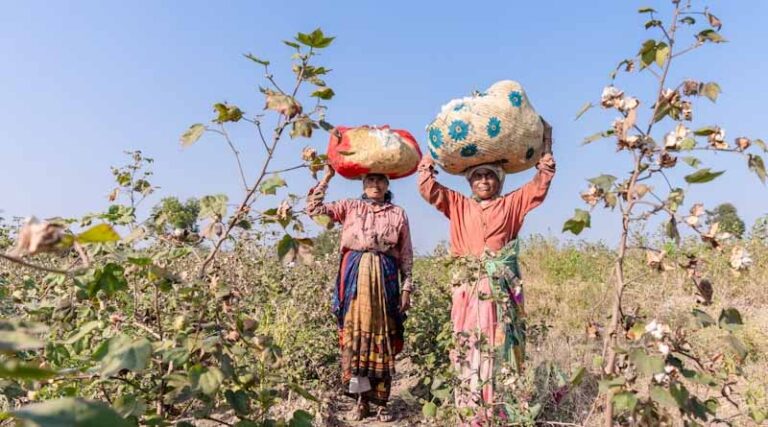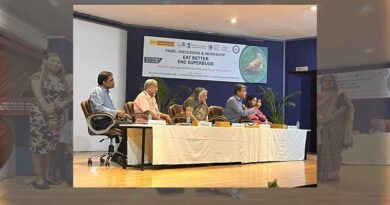
Is TSV Virus Alone to Blame for India’s Low Cotton Productivity? What China Is Doing Differently
By Nimish Gangrade, Editor, Global Agriculture
30 August 2025, New Delhi: India’s cotton sector is facing a critical juncture. Union Minister for Agriculture and Farmers’ Welfare, Shivraj Singh Chouhan, had announced a high-level national meeting that was held in Coimbatore in July 2025, to address the alarming decline in cotton productivity. While the Tobacco Streak Virus (TSV) has been identified as a major cause of recent crop losses, the deeper issue may lie in India’s overdependence on genetically modified (GM) Bt cotton and the lack of innovation in developing high-yielding local varieties.
India’s Declining Cotton Trends
As per official figures from the Ministry of Agriculture & Farmers’ Welfare, cotton cultivation in India has shrunk considerably in recent years. Between 2020–21 and 2024–25, the acreage declined from 132.86 lakh hectares to 112.30 lakh hectares—a compound annual growth rate (CAGR) of -4.12%. Production also dropped from 352.48 lakh bales to 306.92 lakh bales, showing a CAGR of -3.40%.
Cotton Production Trend in India (2020–2025)
| Cotton | 2020-21 | 2021-22 | 2022-23 | 2023-24 | 2024-25 | CAGR |
| Area (Lakh Ha) | 132.86 | 123.72 | 129.27 | 126.88 | 112.30 | -4.12 |
| Production (Lakh Tonnes) | 352.48 | 311.18 | 336.60 | 325.22 | 306.92 | -3.40 |
| Yield (Kg/Ha) | 451 | 428 | 443 | 436 | 465 | 0.77 |
Although yield per hectare saw a marginal improvement—from 451 kg/ha in 2020–21 to 465 kg/ha in 2024–25—the gains were too small to offset the decline in acreage. The TSV virus certainly aggravated matters, but the structural problem appears to be India’s reliance on Bt cotton without parallel efforts to improve its own locally adapted varieties.
China’s Contrasting Cotton Story
In stark contrast, China has pursued a different path. Instead of depending primarily on GM imports, China invested heavily in its own locally developed varieties, which now dominate its cotton production. As a result, China’s productivity has consistently remained double that of India and even higher than the United States.
Over the last decade, China’s average cotton yield has ranged between 1,500 and 2,400 kg/ha—roughly 100% higher than India’s current yield of 465 kg/ha. This massive gap highlights the urgent need for India to rethink its cotton seed strategy and focus on homegrown, climate-resilient varieties.
Combined Cotton Production Data: India vs China
| Year | India – Area (Lakh Ha) | India – Production (Lakh Bales) | India – Yield (Kg/Ha) | China – Area (Lakh Ha) | China – Production (Lakh Bales) | China – Yield (Kg/Ha) |
|---|---|---|---|---|---|---|
| 2020-21 | 132.86 | 352.48 | 451 | 30.5 | 293.0 | 2,092 |
| 2021-22 | 123.72 | 311.18 | 428 | 29.5 | 267.0 | 1,971 |
| 2022-23 | 129.27 | 336.60 | 443 | 31.0 | 307.5 | 2,160 |
| 2023-24 | 126.88 | 325.22 | 436 | 28.5 | 273.5 | 2,089 |
| 2024-25* | 112.30 | 306.92 | 465 | 29.0 | 320.0 | 2,402 |
| 2025-26 | — | — | — | 29.5 | 315.0 | 2,325 |
| CAGR | -4.12% | -3.40% | +0.77% | -0.66% | +1.46% | +2.12% |
The data highlight a stark contrast between India and China’s cotton performance. While India cultivates nearly four times more land under cotton than China, its yields remain less than one-fourth. Over 2020–2025, India’s cotton area and production steadily declined, with only a marginal rise in yield that was insufficient to compensate for the shrinking acreage.
In contrast, China, with far smaller acreage, consistently achieved yields above 2,000 kg/ha, almost double India’s levels, enabling stable or rising production. This trend shows that India’s cotton challenge is not just about pests like the TSV virus but also about seed strategy—China’s reliance on locally bred varieties has driven efficiency, while India’s overdependence on Bt cotton has left its productivity stagnant.
The Bigger Question: Policy and Research Priorities
While TSV virus has emerged as a visible threat, the cotton crisis in India cannot be attributed to a single factor. Shrinking acreage, high input costs, and dependence on a narrow set of GM technologies have all contributed to stagnating productivity.
It is also a known fact that China has been far more aggressive in using agrochemicals to manage its pest load, ensuring that crop losses remain minimal. This heavy reliance on chemical interventions, combined with strong seed breeding programs, has allowed China to consistently achieve yields above 2,000 kg/ha. The question for India, however, is whether simply increasing agrochemical use would help close the productivity gap.
India’s experience with Bt cotton shows that without parallel investment in developing high-yielding, locally adapted varieties, pest management alone cannot deliver sustained gains. If the current varieties themselves are hitting a ceiling in terms of yield potential, then doubling down on chemicals may only increase input costs without proportionate returns. This suggests that India’s path to matching China’s cotton productivity must go beyond pest control strategies and focus on seed innovation, resilience, and locally developed varieties that can thrive under Indian conditions.
The challenge before policymakers and researchers is clear: India must move beyond its one-dimensional reliance on Bt cotton and invest in diverse, locally bred, high-yielding, and climate-resilient cotton varieties. Only then can India hope to close the productivity gap with China and ensure that its cotton farmers remain competitive and sustainable in the global market
Also Read: KisanKraft Marks 20 Years of Service to Small Farmers in India
📢 If You’re in Agriculture, Make Sure the Right People Hear Your Story.
From product launches to strategic announcements, Global Agriculture offers unmatched visibility across international agri-business markets. Connect with us at pr@global-agriculture.com to explore editorial and advertising opportunities that reach the right audience, worldwide.






